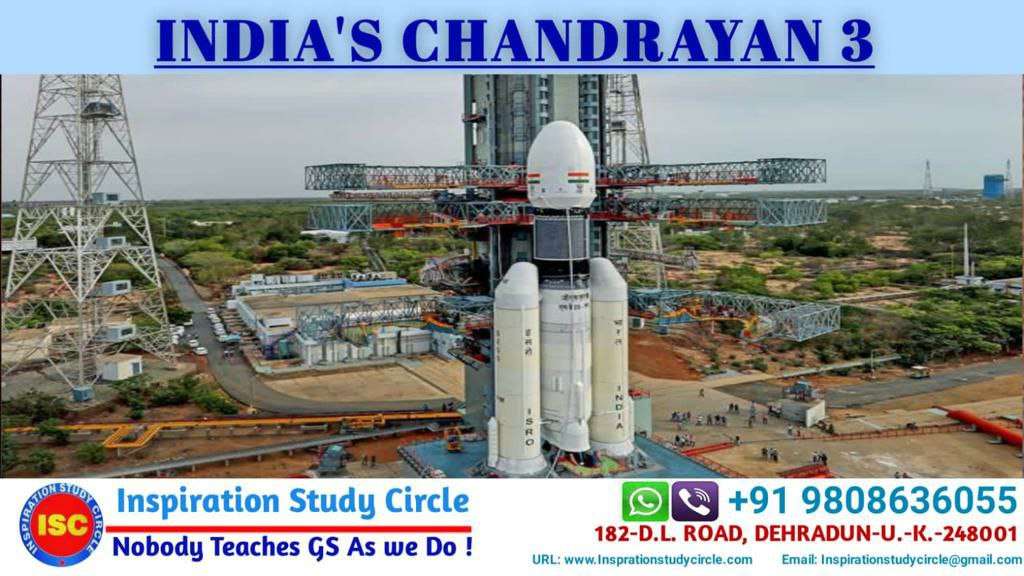
The Viksit Bharat – Guarantee for Rozgar and Ajeevika Mission (Gramin) Bill, 2025
The Viksit Bharat – Guarantee for Rozgar and Ajeevika Mission (Gramin) Bill, 2025 Table of Contents The Viksit Bharat – Guarantee
India soars to new heights. Chandrayaan 3 takes flight, making another remarkable milestone in our space exploration journey. This is a historic mission, as India takes a giant leap toward unraveling the mysteries of the moon and pushing the boundaries of scientific discovery.

Specifications and Details:
Chandrayaan 3 is a follow-up mission to Chandrayaan 2.
This is India’s third lunar mission and its second attempt to achieve a soft landing on the lunar surface.
The mission took a successful flight on 14th July 2023 at 2: 35 pm, from Satish Dhawan Space Centre in Sriharikota, Andhra Pradesh.
The flight duration is around 40 days, expected to be landed on August 23rd or 24th.
The estimated cost of the mission is around INR 615 Crore.
The Objectives of the Mission:
Chandrayaan-3’s mission is not just about reaching the Moon, it also aims to conduct scientific experiments to study the lunar environment, including its history, geology, and potential for resources.
Chandrayaan 3 is a ‘Lunar Landing’ type of mission.
The initial objective is to increase the spacecraft’s altitude before starting a direct trip to the moon.
Once Chandrayaan-3 reaches the moon, it will move further to lower its orbit and settle into a circular orbit about 100 km above the moon.
The second aim of Chandrayaan 3 is to demonstrate end-to-end capability in Safe and Soft landing on the lunar surface.
The next in line is for the Rover to rove on the Moon’s surface and to conduct undisturbed experiments.
To study the composition and distribution of Lunar Water.
To study the geology and mineralogy of the Moon’s South Polar region.
To study and investigate the Lunar environment and its impact on the evolution of the moon.
Significance for India:
Historic Move: Chandrayaan 3 is the World’s first mission to soft-land near the Lunar South Pole.
Milestone Achievement: India will be the fourth country in the world to have made a landing on the moon. With this mission, India will join the ‘Elite Space Club’ where only 3 countries have managed to land on the moon: –
The United States of America
The Erstwhile Soviet Union
China.
Technology and Specifications Involved in Chandrayaan 3:
Chandrayaan 3 consists of a Lander Module Vikram, Propulsion Unit, and Pragyan Rover.
The mass of the Propulsion Unit is 2145 Kg, and that of the Lander is 1749.86 Kg. The mass of the Rover is 26 Kg. That makes a total payload mass of 3900 Kg.
The lander (Vikram) and Rover (Pragyan) of Chandrayaan 3 carry the same specifications as Chandrayaan 2.
The units are launched by LVM-3 M4, developed by ISRO, the most powerful rocket in the organization’s fleet.
Launch Vehicle Mark-3 or LVM3 (formerly known as Geosynchronous Satellite Launch Vehicle Mark III or GSLV Mk III) is a three-stage medium launch vehicle developed by the Indian Space Research Organization (ISRO).
It is powered by CE-20, which is India’s largest cryogenics engine.
The CE-20 is a cryogenic rocket engine developed by the Liquid Propulsion Systems Center (LPSC), a subsidiary of the Indian Space Research Organization (ISRO). It was developed to improve the top level of LVM3. This is India’s first cryogenic engine to have a gas generator cycle.
There are four scientific payloads for passive testing to help accurately measure lunar earthquakes, lunar surface thermal properties, surface plasma changes, and the distance between Earth and the Moon.
The rover has two payloads designed to study the chemical and mineral composition of the lunar surface and determine the composition of elements such as magnesium, aluminum, and iron in lunar soil and rocks.
To optimize Chandrayaan-3’s journey, the vehicle is following a circular path instead of a straight path.
A direct trip to the moon would require a bigger rocket and more fuel. Using gravity and carefully timed shots, the spacecraft can take longer distances to the destination and save fuel.
The Design and Payloads involved in Chandrayaan 3:
What are SHAPE, RAMBHA-LP, CHaSTE, ILSA, APXS, and LIBS of Chandrayaan 3?
According to a PTI report, the importance of the Chandrayaan-3 mission, unlike before, is the heavy load of the Propulsion Module – SHAPE – Spectro-polarimetry of the Habitable Planet Earth, to study the Earth from lunar orbit.
SHAPE is a pilot project to study Earth’s Spectro-polarimetric signature in the infrared wavelength range, ISRO said.
In addition to the SHAPE payload, the main function of the Propulsion Module is to transfer the Lander Module from the injection orbit of the launch vehicle to the Earth separation.
The Lander module has payloads such as RAMBHA-LP to measure nearby plasma ion and electron density and fluctuations, ChaSTE (Chandra Surface Thermophysical Experiment)- to measure the thermal properties of the lunar surface near the poles, and ILSA (Instrument for Lunar Seismic Activity) to measure seismicity around the landing site and delineating the structure of the lunar crust and mantle.
After a soft landing, the rover will leave the surface module and study the lunar surface using the APXS (Alpha Particle X-ray Spectrometer) to obtain the chemical composition and mineralogical composition to improve understanding of the lunar surface as well as the lunar water.
With a mission life of 1 day (14 Earth days), the rover has another payload, the Laser Induced Breakdown Spectroscope (LIBS), to determine the elemental composition of soil and rocks.
How is Chandrayaan 3 different from Chandrayaan 2?
The third edition of the lunar mission comes four years after the partial failure of Chandrayaan-2, which landed on the moon in 2019. Although the architecture of the mission remains the same, there are some differences between the two missions.
The ISRO Chairperson S. Somanath informed that instead of a success-based design in Chandrayaan-2, they focussed on a failure-based design in Chandrayaan-3 —they looked at what can go wrong and how to deal with it.
ISRO has introduced the following visible changes in the Chandrayaan-3 mission:
This mission aims to achieve what its predecessors failed to do – to land on the lunar surface with a soft landing and explore with a rover.
Although the current mission does not carry an orbiter, Chandrayaan 3 will use data from the orbiter of Chandrayaan 2. The payload weighs slightly more than the previous mission, with the Lander making up most of the excess weight.
The landing area has been expanded. Instead of trying to reach a special 500m into 500m patch for landing as Chandrayaan-2 targeted, the mission is now ordered to land safely anywhere in the 4km x 2.4km area.
The Lander is provided with more fuel, so it can travel further to the landing site or an alternate landing site if necessary.
The Lander will no longer depend on the photo he clicked during his descent to determine his landing point. Chandrayaan-2 orbiter has taken a high-resolution image of the ground and will click on the image to make sure that it has reached the right place.
Changes are also made to the physical structure of the lander. The central thruster on the lander was removed, reducing the number from five to four.
The legs have been made sturdier to ensure that they can land even at high speeds. More solar panels have been added to the lander body.
What makes the Lunar South Pole so Important?
The moon has always intrigued scientists, philosophers, space enthusiasts, and ordinary people. Of particular interest to science enthusiasts is the South Pole, the southernmost point on the Moon.
The South Pole of the Moon, also known as the Lunar South Pole, is of particular interest to scientists due to the presence of water ice in the region that has a permanent shadow around it.
The moon has a unique crater at its south pole because sunlight cannot reach its interior.
NASA even stated that some craters on the Moon’s south pole have not received sunlight for billions of years, and the temperature there can drop to -203 degrees Celsius. Therefore, this crater is a cold trap containing the remains of hydrogen, water ice, and other sparks from the first day of the Sun.
Given this cold temperature, the substance trapped in the southern region of the Moon would not have witnessed much change over the years, so it could indicate early life. This factor makes the south pole of the Moon attractive for scientific research.
Previous Explorations to the Moon’s South Pole by India
In 2008, ISRO launched the Lunar Impact Probe (MIP) from the lunar orbiter Chandrayaan-1 on November 14th and crashed about 25 minutes later on the outskirts of Shackleton Crater. Shackleton is an impact crater at the south pole of the Moon. With this mission, India became the first country to reach the south pole of the Moon on very dry ground.
India’s second Chandrayaan-2, launched on July 22, 2019, attempted a soft landing on the Moon’s south polar region. Unfortunately, the Lander could not land safely and lost contact 335 meters above the ground.
Why Choose ISC – The Best IAS Coaching in Dehradun – for UPSC Preparation
Looking for the perfect UPSC preparation in Dehradun? Inspiration Study Circle (ISC) is your answer! ISC stands out as the best IAS coaching in Dehradun, offering exceptional focus on current affairs.
With ISC, you’ll benefit from experienced faculty providing personalized attention, ensuring a thorough grasp of subjects, including the latest updates in current affairs. Regular mock tests will refine your exam skills, while the motivating learning environment and strategic location will boost your concentration.
Choose ISC, the best IAS coaching in Dehradun, and embark on the path to success, turning your dream of becoming an Indian Administrative Service (IAS) or Provincial Civil Service (PCS) officer into reality! Don’t miss out on the opportunity to excel – make the right choice with ISC!
Disclaimer: the article is based on the following sources of information: The Mint and Indian Express.

The Viksit Bharat – Guarantee for Rozgar and Ajeevika Mission (Gramin) Bill, 2025 Table of Contents The Viksit Bharat – Guarantee

How to Prepare for UKPCS 2026 in Six Months Table of Contents ISC- How to Prepare for UKPCS 2026 in

UKPSC Upper and Lower PCS Combined Batch for 2026-2027 Table of Contents Unlocking Uttarakhand’s Civil Services: The Power of UKPCS

Explained: Russian President Vladimir Putin’s State Visit to India Table of Contents Russian President Vladimir Putin conducted a state visit

UPPSC Upper PCS 2025: Mains Test Series and Answer Writing Table of Contents Inspiration Study Circle- Dehradun The UPPSC PCS

The Sanchar Saathi App Table of Contents The Sanchar Saathi app is a security and user-protection platform developed by India’s Department of Telecommunications (DoT) to help users manage mobile connections, report fraud, and locate lost phones